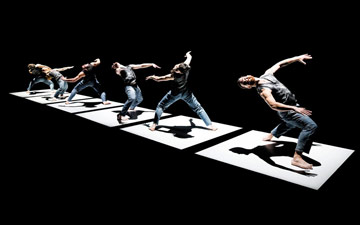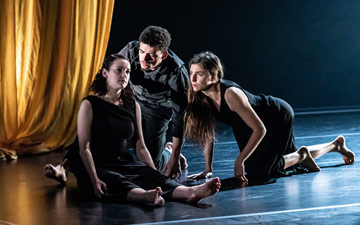
© Rhys Cozens. (Click image for larger version)
National Dance Company Wales
Folk, Atalaÿ, Tundra
★★★★✰
London, The Place
3 May 2018
www.ndcwales.co.uk
www.theplace.org.uk
Several days have elapsed since I saw this triple bill, but vivid memories endure, of distinctive imagery and purposeful choreography performed by a slick and professional company of dancers, evidently invested body-and-soul in their endeavours.
This opening night at The Place was prefaced by the launch of the Rural Touring Dance Initiative for 2018-2021, an Arts Councils’ funded programme that aims to get dance performances out to rural audiences in village halls and festivals; the link to the following performance being that one of the two major grants in the next three-year iteration will be £10,000 for a new work to be created by an artist or company based in Wales.
Launching a rural dance initiative in London seemed a neat entrée to the National Dance Company Wales, appearing with a mixed programme of work themed on rurality, more particularly in evocations of folk tales and ambiguous ethnic mythology.
Caroline Finn – formerly artistic director, now resident choreographer – opened the programme with her subterranean fairy tale (from 2016, her first work on the company), starkly entitled Folk; portraying a community of misfits living under the spidery roots of a giant tree that dominates half the space above the dance floor. The subterranean concept is entirely my construct since it appears that the choreographer’s imagination has actually placed the fugitives in an abandoned landscape; perhaps, marooned on an island.
Elena Sgarbi’s twitchy character, sporadically chattering incoherently in Italian, was often to the fore amongst this quirky group. Are they outcasts? Guardians of this magical tree, apparently rooted in the air? Or, are they simply, societal renegades? Whatever their situation, the nine-strong ensemble assume aspects of normality: seated on a bench; performing mundane chores; breaking out into groups; squabbling; above all, building relationships and alliances that develop and fracture, leaving characters isolated.
A romantic interlude arrives, mid-way, enveloped in a duet by Kat Collings and Cyril Durand-Gasselin, which like all other associations, disappears as quickly as it was established. Tim Volleman opened the work by brushing leaves into a heap, and there is a surprise in the sudden reveal of Julia Rieder from within the pile, leading to a brief duet for “sweeper” and “hider”, under the mother tree.
Finn has a distinctive style that moulds spectacle and intimacy into an attractive package of fluid choreography in which many actions occupy the same moment. In Folk, she has crafted a fairy tale for our age; one that is vintage and modern, this latter side etched with concerns of urbanism, alienation and homelessness. Her creative vision has been delivered in collaboration with Joe Fletcher’s set, dominated by that monumental tree; and Gabriela Slade’s eclectic mix of costumes, albeit in colour ways that matched the setting of tree roots and leaves. There is so much to unpack from Folk that it would evidently repay multiple viewings to fully appreciate the choreographic and allegorical complexities that have been condensed into just 28 minutes.

© Rhys Cozens. (Click image for larger version)
The two succeeding works have both been mined from Spanish minds: a 2018 premiere for Mario Bermudez Gil’s Atalaÿ; and a revival of Tundra by Marcos Morau who is gathering critical acclaim for his work with Barcelona-based, La Veronal. Both pieces continue the theme of disconnected communities.
Atalaÿ is a comparatively long quartet, again suggestive of the changing patterns of life within an isolated and nomadic group. The title and the music indicate a subliminal Turkish theme although that is not obvious in the movement, which takes many different styles from pulsating energy to reflective subtlety. Danced by Nikita Goile, Ed Myhil, Julia Rieder and Mathew Prichard, Atalaÿ was the story of a journey, evidently embracing seasonal change and suggestive of the significant passage of time. The dance was slick and fluid with changing patterns based around a theme of four.
Morau’s Tundra was another returning work and one that seemed the most fixed in terms of place and time, being (according to the choreographer, in an interview at the time of its premiere, last autumn) inspired by the centenary of the Russian Revolution; although, there is no way I would have deduced that, without this steer.
The dominating imagery of Tundra comes in the austere lighting (again, by Fletcher, who lit all three works) suggesting the stark, frozen, treeless landscape of the tundra (a word that derives from the Russian for “uplands”) and in Angharad Matthews’ distinctive costumes; beginning with long floor-caressing skirts, which – when discarded – revealed richly-textured, multi-patterned “uniforms”, conveying some evocation of an Inuit style in their patterning. A strange musical mix of Russian and Icelandic songs and poems heightened this evocation of nomads in a sub-arctic wasteland. Morau’s choreography is all about togetherness, with eight dancers striving to work in continual unison. Whatever the meaning, Tundra is a compelling and effective work that presents the dancers as if integral components of one well-oiled machine; and it holds a striking visual impact throughout.
NDCW comprises a rich mix of performers, collectively hailing from six countries (although, surprisingly, none appear to have any Welsh heritage). What is even more surprising is that all bar one have joined in the past nine months; an annual turnover that is surprising even for a dance company! Nonetheless, this new generation has quickly assembled into a cohesive unit that impressed across this fascinating programme.

















You must be logged in to post a comment.